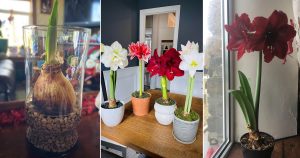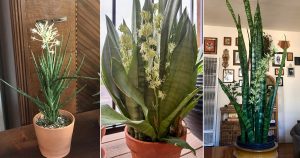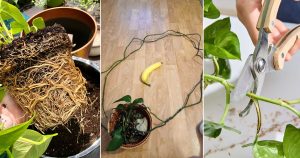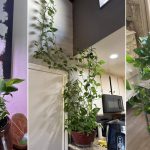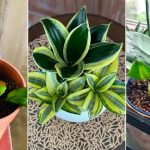Is your balcony totally shaded by another building or tall trees? That’s okay, despite what you may have heard, you can still have a beautiful container garden in the shade. I’ve written a few posts about gardening in the shade, but this is a step-by-step guide to help make your shady container garden look great!
First: Determine how much shade you have. You do this by watching your balcony on a day when you’ll be around most of the day. Simply stick your head out every hour or so and observe whether it is sunny or shady on your balcony. Keep in mind that you may have different types of shade on different parts of your balcony.
- 3-6 hours of sun means your balcony is suitable for partial sun and partial shade plants.
- If your balcony gets a continuous stream of light filtered through the branches of a tree or some other similar obstruction, your balcony is suitable for plants that need dappled or filtered light.
- If you get less than 3 hours of sun, then your balcony is suitable for plants that need full shade.
Second: Select plants appropriate to the amount of shade on your balcony. Below you will find a few suggestions, but this list is not exhaustive!
If you have 3-6 hours of sun:
- Monkshood (Aconitum) – A member of the buttercup family, this plant has tall, long-lasting flower spikes in shades of blue, purple, white, yellow, or pink.
- Blackberry Lily – The foliage looks similar to an Iris, but the flower is deep orange and tropical looking.
- Bleeding Hearts (Dicentra) – Has delicate strands of white or light pink flowers.
- Primrose – Comes in a wide variety of pastel colors, flowers cover a compact bushy plant.
Dappled light:
- Columbine (Aquilegia) – Delicate flowers in red, pink, yellow, white and purple.
- Trillium – As the name suggests, this plant has small, three-petaled flowers in white or red. Don’t pick the flowers as this often damages the plant.
- Bluebells – In Spring, these plants are covered in small, blue, bell-shaped flowers lined up in orderly rows along arched stems.
- Caladium – Large, tropical leaves flecked with white, green and magenta.
- Japanese Maples (Acer palmatum) – Dwarf varieties are best for balconies. Japanese Maples come in a wide variety of leaf shapes, colors and growth habits; everything from lacey, wine colored leaves of weeping branches to bright green, upright, bushy varieties.
Full shade:
- Astilbe – Has fern-like folliage that looks good all season long and long lasting flowers.
- Bleeding Hearts (Dicentra) – Has delicate strands of white or light pink flowers.
- Trilium – As the name suggests, this plant has small, three-petaled flowers in white or red. Don’t pick the flowers as this often damages the plant.
- Ferns – Check out some of the more unusual varieties, like the silver-leafed, red-veined Japanese Painted Ferns.
Third: After you have selected your plants, you will need potting soil, fertilizer and pots. Definitely read the tags of the plants you purchased, but keep in mind that many shade loving plants were originally found growing on forest floors. The soil in this sort of area is rich in nutrients and slightly acidic. If you can find potting soil specially designed for Azaleas, it will probably be good for your shade loving plants. Whatever you do, do not use soil from the garden. It is often too clay-like for container gardening and it may harbor diseases, pests and weeds.
Also, the large amount of leaf mulch on forest floors and the shade provided by overhead trees keeps the soil cool and moist. For this reason, it is probably best to chose glazed terra cotta pots that will help keep the soil cool and moist.
As far as fertilizers go, those meant for azaleas will help keep the soil pH on the acidic side. Although don’t over do it. If you purchased potting soil meant for Azaleas, you may not need Azalea fertilizer. It’s always best to read the tag of the plants you buy and follow what you find on the tag.
Fourth: Planting! Arrange your pots in their intended locations because larger pots can be difficult to move after being filled with soil and plants. Fill the pot farthest in the back partially with soil. Mix in some time-released fertilizer. Then, without removing the nursery pots, arrange the plants you intend to put in that pot. This post has an easy-to-follow recipe for good looking containers. When you’ve found a pleasing arrangement, gently remove the nursery pot, gently loosen the roots if they are rootbound, and place the plant in your desired location. You want the base of the plant to be about an inch below the lip of the pot, so add or remove soil to achieve that goal. Repeat this process with the rest of the plants. Fill in the holes between the plants with more potting soil. Repeat this process with the remaining pots, working from back to front. When all of your pots are planted, water each of them thoroughly, but try not to get water on the leaves of your plants.
Fifth: Caring for your plants. As I mentioned previously, shade plants tend to like moist soil. Check your plants regularly and water whenever the top of the soil feels dry. However, don’t over do it with watering. Most plants do not like to sit in sopping wet soil. The goal is to keep the soil evenly damp, not soggy. Also, try not to get water on the leaves of your plants. Shady environments are ripe for mold, mildew and fungus growth. Keeping water off the leaves will help nip that in the bud.
Fertilize your plants regularly according to their needs and the fertilizer package instructions. Keep in mind that container plants often need more frequent fertilizing that plants that grow directly in the ground because the nutrients are washed out of the soil every time you water.
Keep an eye out for snails and slugs, they like the shade too! Most balconies are high up enough that snails are not a problem, but if you are on the first floor, you might see a few. Other than picking them off as you see them, Marye of Simply Home Remedies has compiled a list of different natural snail control remedies that don’t require harsh chemicals.
Sixth: Enjoy your garden!
If this post was useful to you, subscribe to my posts so that you never miss a single great post about container gardening!

